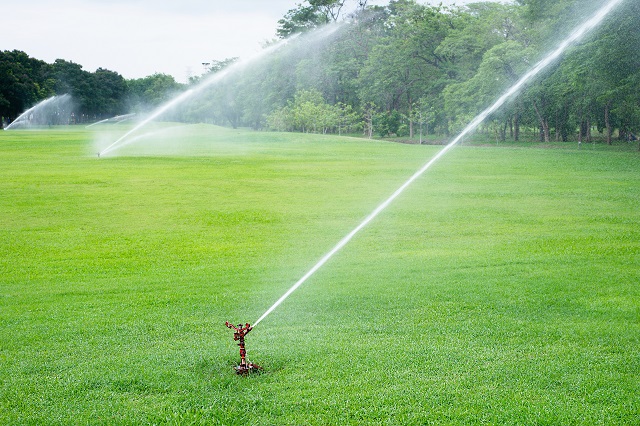Understanding Soil Chemistry and Soil Structure
Whilst there are differing views on how to test, interpret, modify and support good soil chemistry there is a consensus in the turf management community that the root systems we so heavily depend on need a healthy soil environment. That healthy soil environment involves many elements from microbiology to biochemistry and a range of items in between. The fact there are many differing views on specifics of this subject area is acknowledged, however we do have some useful history that suggests the basic principles we have worked with to date have served us fairly well. So, if we at least start at that point, and try to stick to some basic philosophies that demonstrably have stood the test of time we can be reasonably sure we will continue to work towards some good outcomes.

The two category system
Broadly speaking soil testing has fallen into a couple of categories for analytic purposes. Low CEC soils and moderate to high CEC soils. The low CEC soils are generally sands of poor nutrient holding potential and for these we are more focused on simply ensuring enough nutrition is available to turf root systems to support the basic needs the living plant has. In higher CEC soils (higher clay or organic matter content) we have a luxury of knowing their inherent characteristics mean minimum requirements are probably being adequately met in most circumstances and we can now go one step further to attempt to arrange some of the desirable chemical components in relative quantities thought to deliver a more optimal soil structure.

LOW CEC soils
Our elite AFL, NRL and cricket grounds are generally constructed with sand dominated profiles that have hydraulic conductivity potentials that ensure obligations for televised sport are never compromised by weather events impacting the playing surface. The investments made in some of these events is so substantial that loss through rainfall that prevents a continuation of play is a cost that justifies accepting some challenges elsewhere. The challenges elsewhere however are on the turf management side – because these fast draining profiles are not necessarily the best matrix in which to grow high quality turf. We have just devised methods and monitoring that allow challenges to be addressed and overcome.
Many local sportsfields have been, or will be, reconstructed employing a profile geared towards better drainage. With rising expectations on our local amenity areas the need for well-presented usable and safe surfaces is driving this with some momentum. Therefore, with the evolution of these sites they move closer to the myriad of issues the high-profile venues experience – just on a moderated scale, and with a very much moderated budget. To be fair it has to be acknowledged many of these modified sportsfields do tend to perform better and provide a more durable and resilient sporting surface that better matches the expectations placed on them by their local communities, but they are constantly needing the same counter measures and careful agronomic management from thoughtful turf professionals. Fortunately as an industry the level of sophistication applied to our practices has truly come a long way. We understand the limitations of these soils and what this means for soil chemistry. We accept there are limitations on the ability of critical cations to be placed and held in those rootzones, and intuitively we know holding water for any period of time and in any quantity is equally challenged.
Logically we would seek to correct this limited holding potential through the addition of materials that significantly change the profile characteristics but this is not often adopted (at least not in any great quantity or speed) as this runs counter to the initial objective and tends to introduce other management problems. Therefore, in regards to nutrition and soil chemistry, we monitor and supplement to mitigate the inevitable losses and very carefully (and slowly) add organically based materials to not introduce black layer or restrictions to penetration or percolation of water.
Analytic reference points for assessing this type of soil defer to a sufficiency level type interpretation which basically seeks to ensure the minimum requirements for health are consistently met as a more luxurious approach simply isn’t physically (or chemically) achievable. A floor is set based on the turf species and if analytic results sit below the floor recommendations are made for additional nutrition.

Moderate to high CEC soils
Conversely, sites developed some time ago on native soils where there is a generous silt, clay or organic matter content tend not to be highly deficient in basic nutrition. The inherent characteristics of these soils allow more of the critical cations to be retained, and anything additional that is applied tends to be well accepted ensuring more than adequate nutrition is perpetually available. It is acknowledged these soils are those for which annual renovation works focus more on enhancing infiltration of water and the movement of this water through the profile – the reverse of the prior situation, but that doesn’t mean the chemistry piece is ignored. Rather, it is optimized.

In these situations where a satisfactory level of critical cations (e.g. Calcium, Magnesium, Potassium) can reliably be considered pre-existing the thinking is to try and optimize soil structure by manipulating the relative concentrations of these to fit a pre-determined model. For the primary cations this has been suggested to be a proportional arrangement of 68-72% Ca, 13-16% Mg and 3-5% K. After taking in to consideration things like soil pH, electrical conductivity, presence / absence / concentration of things like chloride and bicarbonates in irrigation waters, and their concentrations in relation to the primary cations an approach is usually proposed to apply further quantities of targeted components to alter the relative balance in the soil environment towards this model. This should never be done in the absence of a review of irrigation water sources nor should it be the sole decision making information used. Localisation, observation and retrospective analysis of actions and outcomes must be part of this process. Regardless of what a book says – if doing something didn’t improve a situation stop and reassess before doing it again.
Why do we spend so much time on this?
The pursuit of such optimization is actually the pursuit of a soil structure, oxygen potential, biochemistry and a root development environment that can deliver high quality turf surfaces. It’s one of those critical, multi-faceted, indirect relationships that can be difficult to explain to those who have no grounding in turf management or soil science. Good technicians know the green stuff on top is governed by what’s below and we know how complex this interaction can be and how much better turf grows in a helpful soil matrix.

So, without getting too techy, back to the point of sticking with some philosophies that have served us pretty well. History has shown aiming for these sorts of ideal soil conditions does confer benefits to the plant grown within and the ‘crop’ that ultimately can be produced. This principle applies in agricultural cropping just as much as it applies to turf management. There have certainly been differences of opinion on where critical levels should be set, precisely what interpretation method to use, and for that matter which extraction method best supports the interpretations we are trying to make. But the consensus is that working towards these general benchmarks does support better turf so we should not shy away from the application of these principles to help guide us. A very important caveat that must sit over these general principles, and as noted earlier, the soil environment is not a static environment. It is a dynamic system that can and does change over time. One of the inputs known to lead to change that can be highly detrimental to turf is the use of irrigation sources that contain a vast array of salts and / or suspended solids. These salts alter the ‘healthy’ chemical balance in soils and do lead to structural, chemical and growing problems. We therefore monitor the changes occurring and try to mitigate the deleterious effects through the application of counter measures. Those benchmarks discussed above (fully agreed or not) do help set reference points to continue to work back towards and give common targets to calculate the quantities of those counter measures we need to get our amendments approximately right. Blunt tool – yes. Necessary – arguably I suggest yes as well.
How Nuturf can help you
Nuturf has a full analytic service that can sample, analyse, report and recommend how to cater for the different CEC soils we encounter. An extensive suite of soil amendment products are within the Nuturf range to cater for nearly any need a soil may have. Amendments can be liquid, granular or injectible to irrigation water.
We can walk you through the analytic findings, explain to you the rationale behind recommendations, and help you track changes occurring in your soil over time. Nuturf has the technical expertise and vast resources around the country to ensure you deal with a single professional service provider from beginning to end.
RECOMMENDED SERVICES

Managing Soil Moisture: The Evolution of Wetting Agents

Ninemire Soil Report






